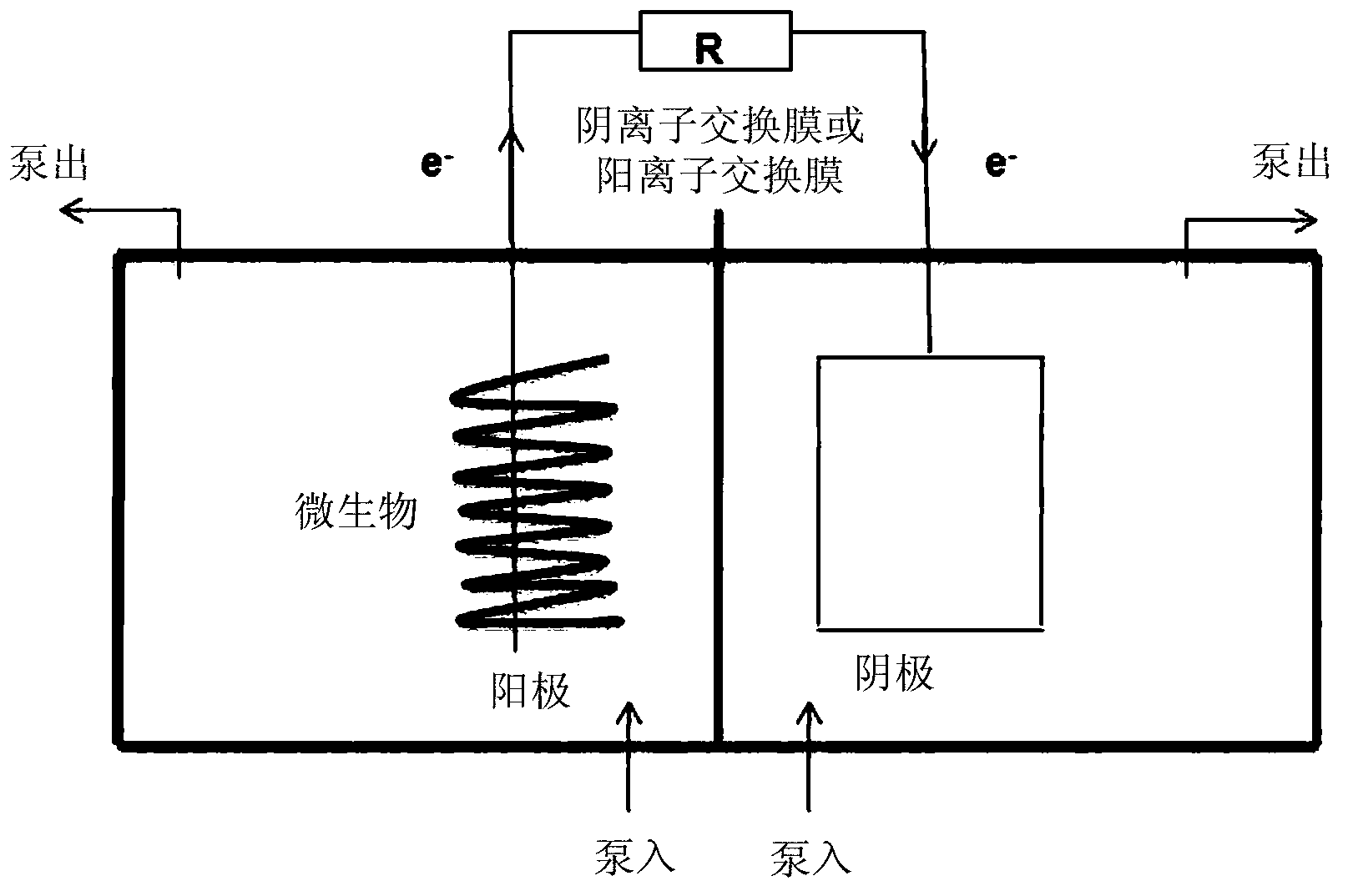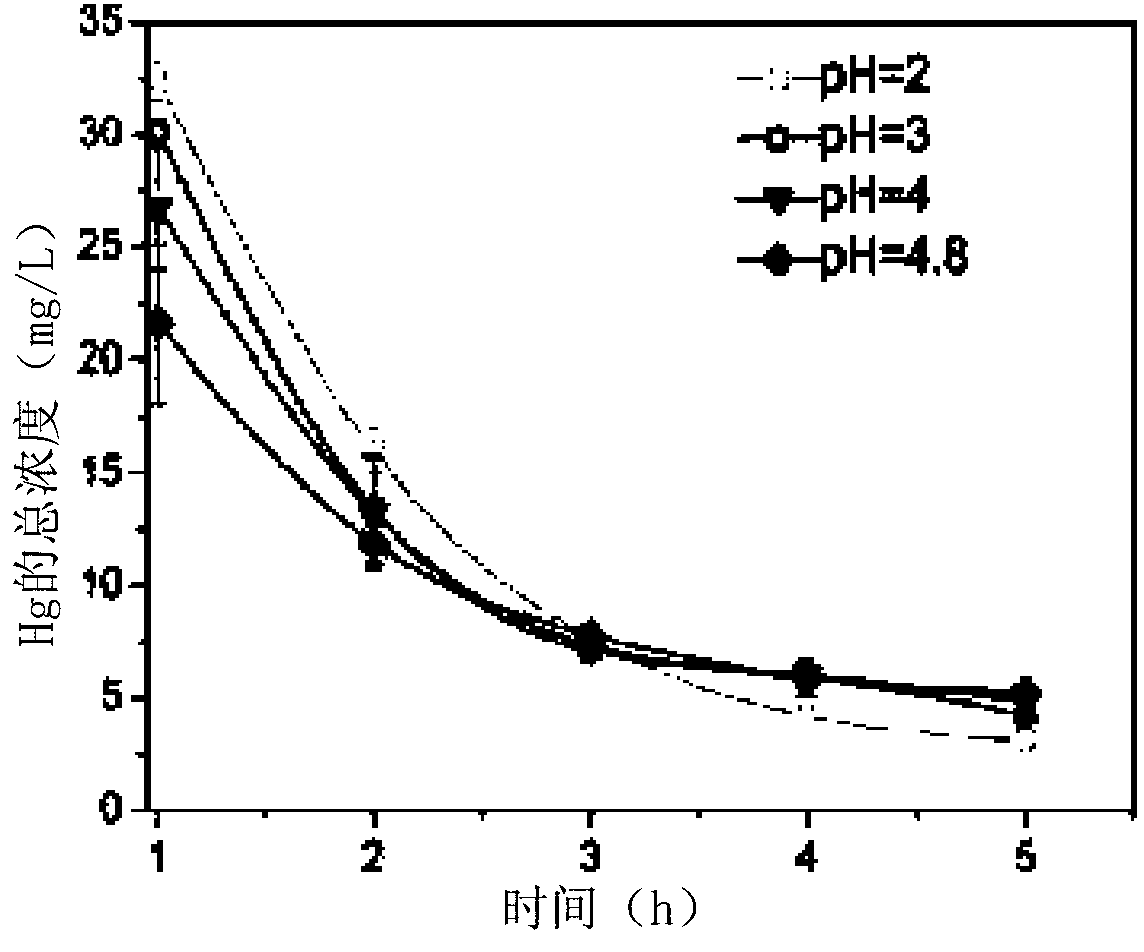Method for heavy metal elimination or precious metal recovery using microbial fuel cell
A technology of fuel cells and microorganisms, applied in biochemical fuel cells, fuel cell additives, chemical instruments and methods, etc., can solve the problems of harmful by-products and high processing costs
- Summary
- Abstract
- Description
- Claims
- Application Information
AI Technical Summary
Problems solved by technology
Method used
Image
Examples
Embodiment 1
[0092] Example 1: Removal of mercury in wastewater
[0093] Hg Removal from Mercury-Containing Wastewater (MWW) Using MFC Technology 2+ ions, we studied the effect of factors such as initial concentration and initial pH on the Hg 2+ The effect of ion removal rate.
[0094] The MFC is assembled in this way: carbon felt is used for the anode (oxide electrode, positive electrode), carbon paper is used for the cathode (reduction electrode, negative electrode), and an anion exchange membrane is used for the membrane between the two electrode chambers.
[0095] (1) MFC installation
[0096] The present invention uses a double-chamber MFC whose electrode chamber is made of resin glass. The volume of the electrode chamber is 137ml (length: 7cm, diameter 5cm), and the effective volume of each electrode chamber is 120ml. Anion exchange is used between the two electrode chambers. Separated by touch (AEM, AMI-7001, Membrane International Inc., USA), the anion exchange membrane area is ...
example 2
[0132] Example 2: from containing Cr 6+ / Cr 3+ Cr removed from wastewater 6+ / Cr 3+
[0133] Figure 7 is a removal of Cr 6+ / Cr 3+ Schematic of the two-chamber MFC. This dual-chamber MFC can provide the front-end voltage to the end when the end voltage is insufficient, so as to remove or recycle metal. Various ions can be removed or recovered using this method.
[0134] In the present example, the conditions of the cathode compartment are listed in Table 2.
[0135] Table 2
[0136]
No. 1 reduction electrode room
No. 2 reduction electrode room
Cr 6+
Cr 3+
Material
Carbon brush 2.5x2.5cm
Carbon cloth 1.7x1.3cm
volume
100ml
100ml
ion concentration
200ppm
100ppm
film
CEM
AEM
pH value
2
Unadjusted, 6.4
K 2 SO 4 concentration
200mM
200mM
Stirring method
Remove N 2
Remove N 2
[0137] Figure 8-12 is shown to use a...
example 3
[0140] Example 3: Removal of As in wastewater 5+ / As 3+
[0141] Figure 15 is to remove As 5+ / As 3+ Schematic setup of the dual-chamber MFC. This dual-chamber MFC is used when the voltage of the rear battery is insufficient, and the voltage provided by the front battery can be used to remove or recover metals. This method can be used to remove or recover a variety of ions.
[0142] Shown in Table 3 are the conditions for the cathode.
[0143] table 3
[0144]
No. 1 reduction electrode room
No. 2 reduction electrode room
ion
As 5+
As 3+
Material
Carbon brush 2.5*2.5cm
Carbon cloth 1.7*1.3cm
volume
100mL
100mL
ion concentration
100ppm
50ppm
film
CEM
CEM
pH value
2
Unadjusted, 9.5
K 2 SO 4 concentration
200mM
200mM
Stirring method
remove N2
remove N2
[0145] Figures 16 to 20 Indicates that it is used to remove AS i...
PUM
| Property | Measurement | Unit |
|---|---|---|
| diameter | aaaaa | aaaaa |
| surface area | aaaaa | aaaaa |
| thickness | aaaaa | aaaaa |
Abstract
Description
Claims
Application Information
 Login to View More
Login to View More - R&D
- Intellectual Property
- Life Sciences
- Materials
- Tech Scout
- Unparalleled Data Quality
- Higher Quality Content
- 60% Fewer Hallucinations
Browse by: Latest US Patents, China's latest patents, Technical Efficacy Thesaurus, Application Domain, Technology Topic, Popular Technical Reports.
© 2025 PatSnap. All rights reserved.Legal|Privacy policy|Modern Slavery Act Transparency Statement|Sitemap|About US| Contact US: help@patsnap.com



